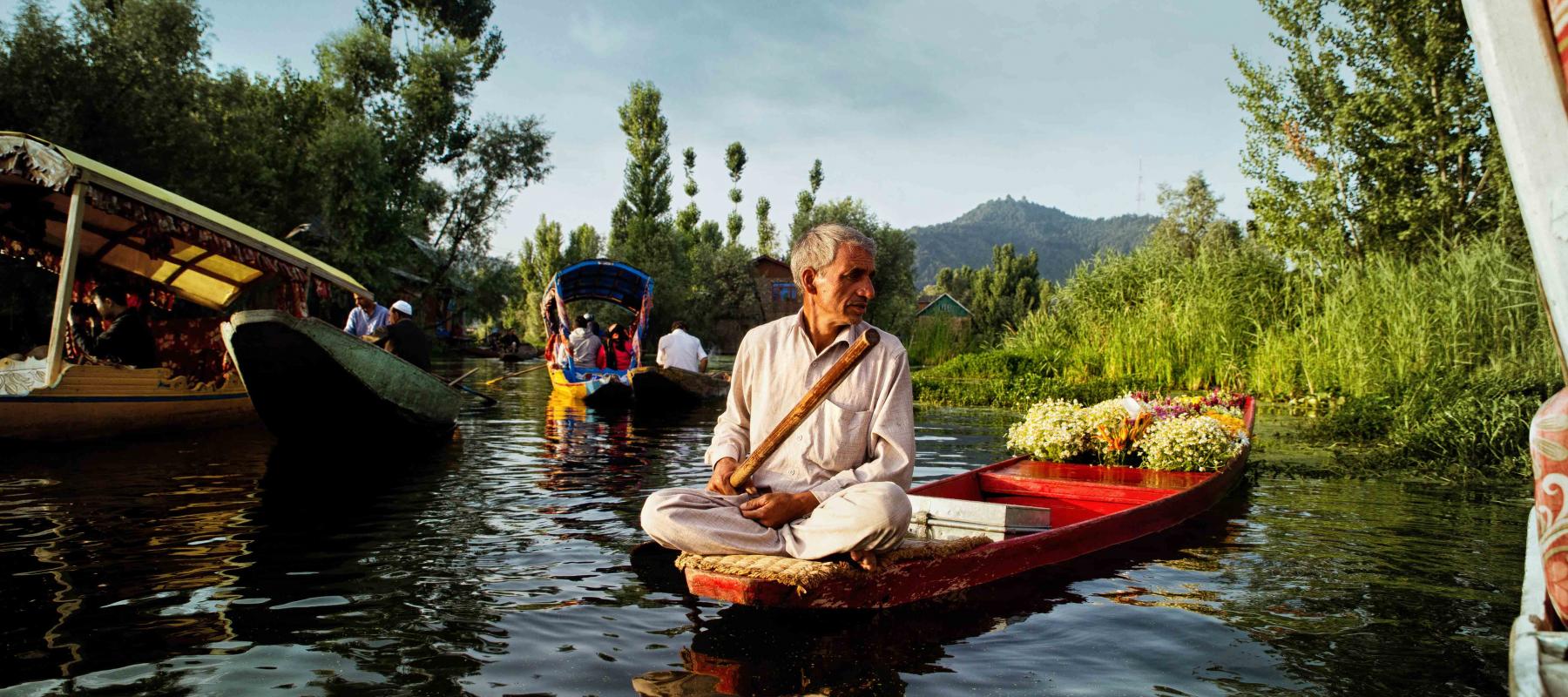The days of spring come back again,
the night of the full moon smiles again,
vakula flowers bloom again on bare branches-
these do not go away.
A thousand times they take their leaves
and return again.
- Rabindranath Tagore

Flowers and Indian culture are inseparable. Their significance in festivals, rituals, weddings or celebrations, auspicious occasions, and even for medicinal purposes is indeed prominent. One such interesting space are the Flower mandis or markets, which offer an experience of vivid life. Their rich historical background makes it a haven for heritage buffs and photographers.
Mesmerizing Floating Market, Kashmir
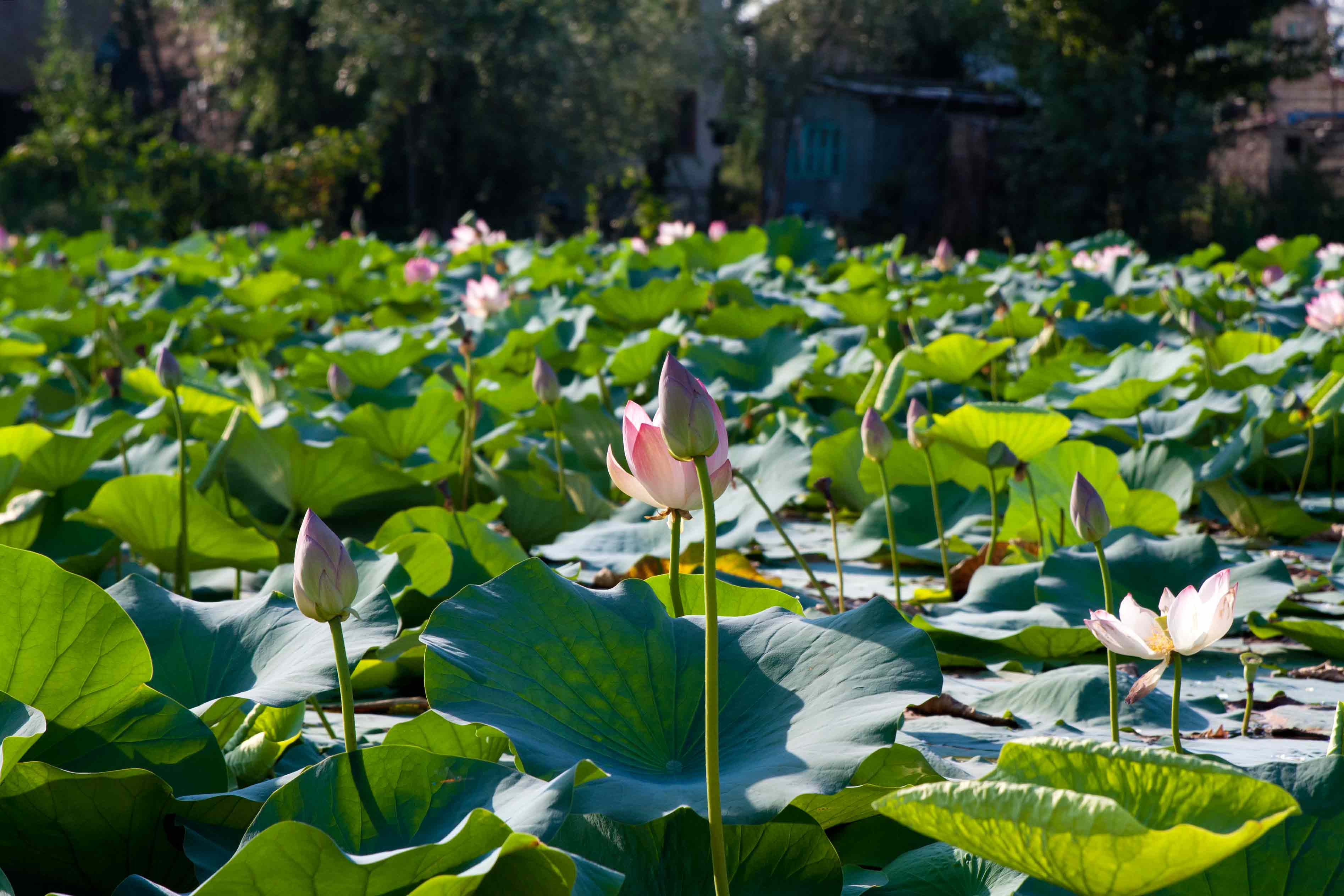
One of the most eye-catching scenes is to witness the floating flower market on Dal Lake in Kashmir. Along the lake, you will see many scenic gardens including the Nishat Bagh and Shalimar Bagh built by the Mughals, and other beautiful parks lined up. The floating gardens on Dal Lake are referred to as rad locally and are known for their beautiful lotus blooms. The locals sell a variety of other flowers such as roses, daisies, water lilies, and a wide range of other produce including vegetables, gems, nuts, Kashmiri bakery products, Kahwa (Kashmiri tea), and saffron on their shikaras (wooden boats). This floating market is also known as Gudri Market, which according to a legend started when the melons of Dal Lake were sent to the Mughal court of Agra, and became an instant hit among the royalty.
Mullik Ghat Flower Market, Kolkata
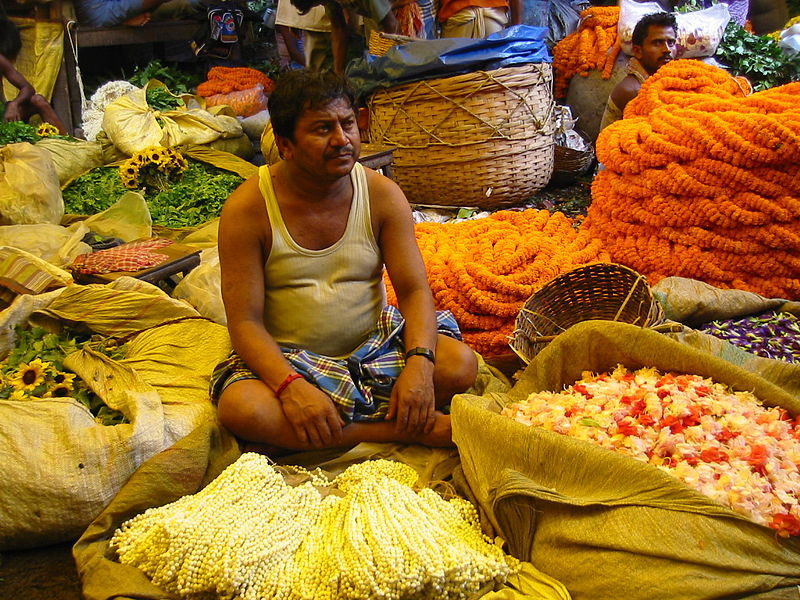
One of the biggest flower markets in Asia, Kolkata’s Mullik Ghat Flower Market starts at 4 am and is open for almost 24 hours. People come from different parts of the city to sell flowers in this market, which is located close to the magnificent Howrah Bridge along the Hoogly riverside. One special flower sold in the market is Tagor phool (Tabernaemontana), a white flower similar to jasmine. Other common flowers sold are roses, orange and yellow marigolds, sunflowers, lotuses, orchids etc. used for the rituals, weddings and ceremonies. The flower market is located next to the Jagannath Ghat, which was built by Ram Mohan Mallick in the eighteenth century in the European architectural style.
Delhi and its Flower Mandis
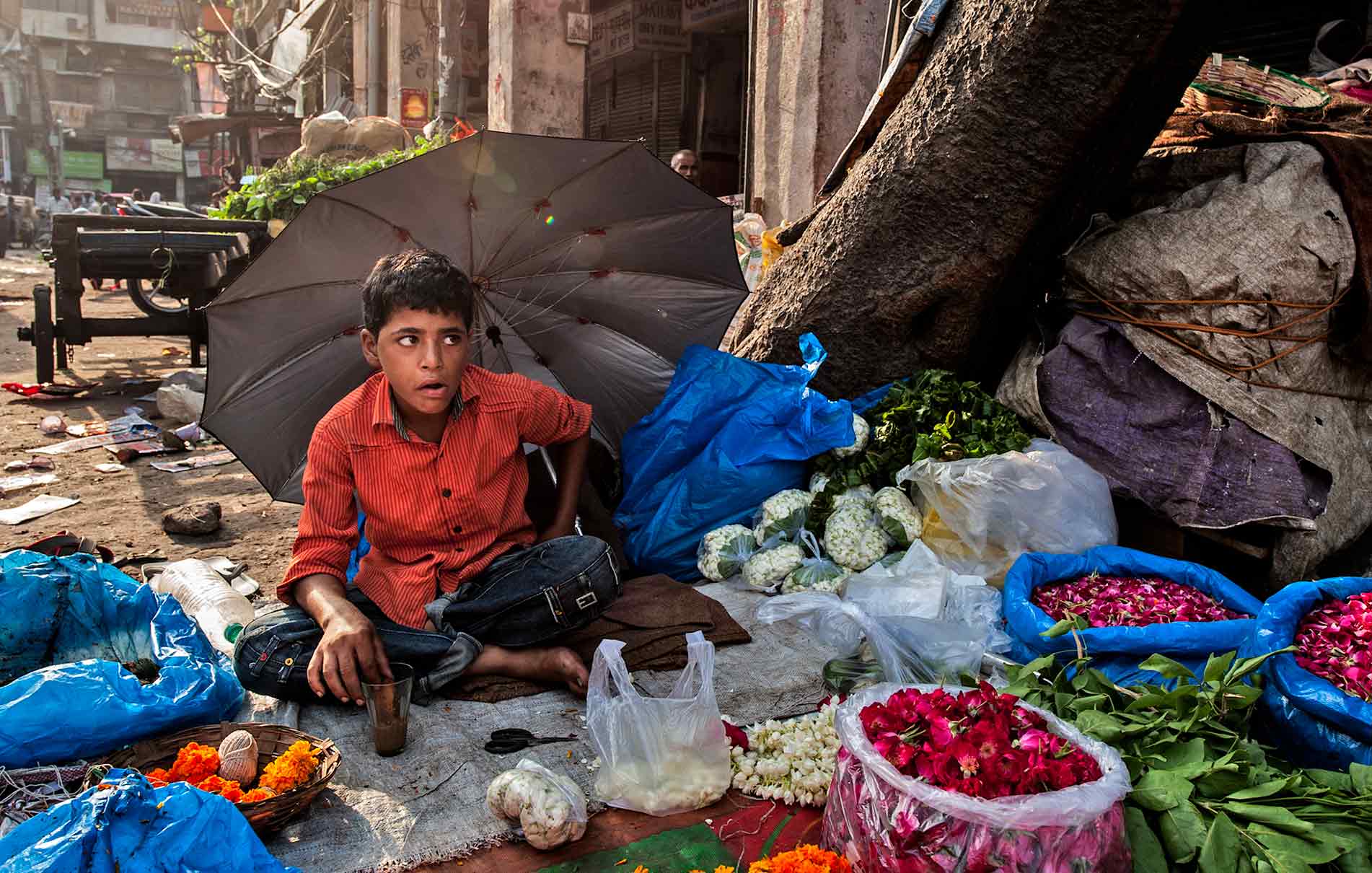
One of the famous flower mandis in Delhi, the Ghazipur Wholesale Flower Market opens at 4 am selling blossoms from different parts of the country and world including South Africa, Thailand, Holland and others. The market sells a wide variety of roses, gerberas, irises, anthuriums, lilies, marigolds, proteases, orchids among others. The mandi was earlier situated opposite the Prachin Hanuman Mandir, at Baba Kharak Singh Marg before it was shifted to Ghazipur. One of the main attractions of the market is Nargis or the Poet’s Daffodil from Kashmir used extensively in perfumes. It grows only in the cold regions of Himachal Pradesh and Jammu & Kashmir.
At the heart of the city, Connaught Place, is another flower market, which was set up in 1995 by Brij Mohan Khanagwal. Besides the exotic flowers from South Asian and European countries, local varieties come from Kolkata, Bengaluru, Maharashtra etc. including carnations, fowl of heaven, rajnigandha, gladiolus and chrysanthemums. The market sells bouquet accessories, gift baskets, artificial flowers as well.
The old and narrow lanes of Chandni Chowk lead you to the flower market of Khari Baoli, a market famous for its spices, ittars (natural perfumes) and nuts. During the British era, the market was between Kotwali (police station) and Dariba Kalan. Later moved close to Fatehpuri Masjid, people started calling it Fatehpuri Phool Mandi. It once sold only loose marigolds thus being called the Genda (marigold) Phool Mandi, but today it sees a heavy traffic both flowers and buyers. The flower market stays open every morning from 3.30 am till about 10.00 am. A seventeenth century Mughal structure, Fatehpuri Mosque gets its name from Begum Fatehpuri, who commissioned the construction of the mosque. Hailing from Fatehpuri, she was one of the wives of Emperor Shah Jahan.
Dadar’s Phool Gali
A renowned commercial and residential hub, Mumbai’s largest and only wholesale flower market is in Dadar. Mostly chaotic and crowded, it brims with a pleasant mix of fragrance of flowers. Besides the flowers and varmalas (wedding garlands), Dadar Phool Gali also sells tulsi (basil) leaves in large scale, as it is used extensively for rituals and ceremonies.
South India is home to many famous flower markets situated in Bangalore, Chennai, Mysore, Madurai, Coimbatore, and Mangalore and so on.
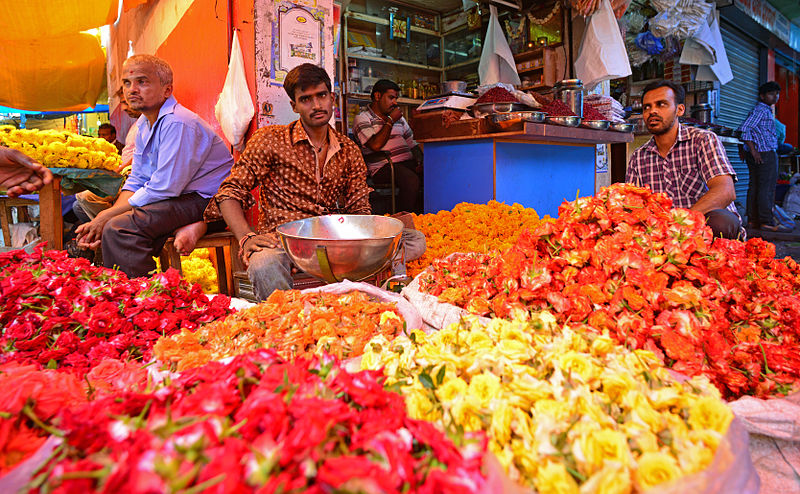
KR Flower Market, Bangalore
The largest wholesale flower market in Bangalore is in Krishna Rajendra or KR market, also known as City Market and Huvina Flower Market (Huvina in Kannada language means flower). What is unique about this market, however, is the fact that the site was once a war field that witnessed the Anglo-Mysore wars in the eighteenth century. The market building came up way later in 1921 and was named after Krishna Rajendra, the king of Mysore. Presently, the market building is three-storied after its revamp in the 1900s and was built between two older buildings. However, even today you will find some parts of the market styled in typical British red and white architecture. A variety of garlands and flowers such as roses, Dutch roses, carnations, lilies, daisies, anthuriums, chrysanthemums, jasmine, tulips etc are sold here every day usually between 12 am and 8 am. This flower market is divided into two sections with almost 85 stalls, one for selling loose flowers, garlands and petals and the other section is primarily for the exotic flowers.
Russell Market, Bangalore
Some sources state that the market dates back to the 1850s. The Municipal commissioner TB Russell initiated the present-day layout of Russell market in 1927 in the Indo-Saracenic style. Interesting to note that the market structure, which was once part of the British Cantonment area, has gothic spires, arches, bulbous domes, old clock towers and pillars—a perfect mix of Ind0-Islamic and colonial architectural elements. Famous for its aromatic flowers such as roses, gladioli, exotic lilies, carnations, birds of paradise, asters and so on, the market sells everything from fruits to vegetables, poultry, and bakery items. Close to all the hustle lies the historic St Mary’s Basilica, Jama Masjid and Muthyalamma Devi temple.
Mysore's Devaraja Market
Dating back to the eighteenth century, a part of this unique heritage market sells garlands and flowers especially the famous Mysore mallige or Mysore jasmine. Patronized by the royalty, it is cultivated in and around Mysore and the adjoining town of Srirangapatna and widely used during special occasions, festivals and weddings. The market structure dates to the 1900s in stages and was named after Maharaja Dodda Devaraja Wodeyar. Today, the market has four entrances and over 80o shops spread across over three acres of land. There are two iconic clock towers close to the market, the smaller tower is called Chikka Gadiyara and the taller one is named Dodda Gadiyaara.
Mangalore Flower Market in Car Street is also famous for the flower of the areca nut tree, a native to the South Kannada region and considered auspicious to the Lord Ganesha. Another commonly sold flower is the Mangalore jasmine, which is mainly grown in Shankarapura, consisting of predominantly Christian communities.
Gudimalkapur Flower Market, Hyderabad
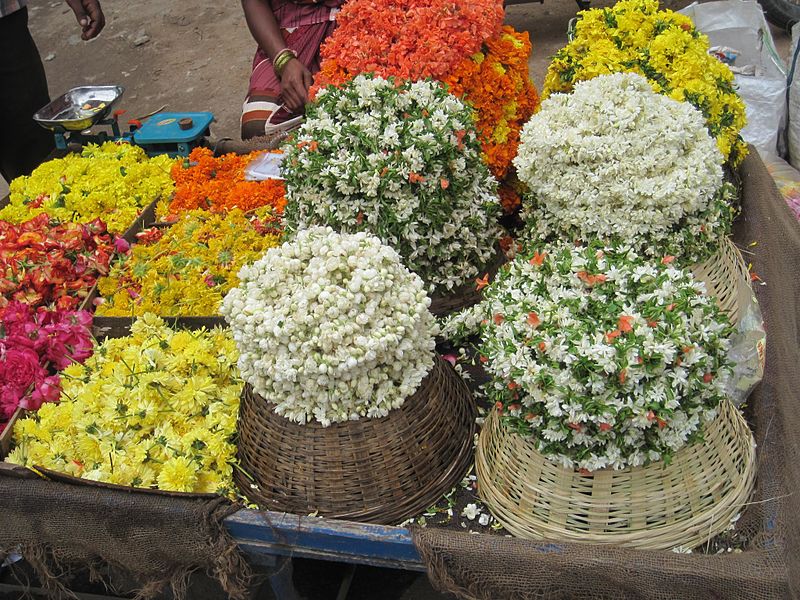
Earlier a part of Moazzam Jahi Market, the flower market, was shifted to Gudimalkapur in 2009. The markets sell native and exotic flowers, which includes rose, jasmine, marigold, daisy, dahlia, orchids, tulips, peonies, floral accessories such as veni and gajra and also tulsi, kanakambaram and maruvam leaves. The market witnesses escalated demands on Bathukamma, a state festival, Ugadi, Diwali, Christmas and other special days. The city of pearls, Hyderabad, has another famous flower market in Jambagh.
There are traditional flower markets in temple towns such as Chennai, Coimbatore and Madurai. One of the largest flower markets of South India, Mattuthavani market in Madurai is famous for the Madurai malli or jasmine, and champak or sampangi.
Banner Image Credits - Sharmistha Dutta, Sahapedia.org
